Spring weeds are now appearing
It has been quite a while since I’ve posted any articles, but this is a time that we need to get outside and check out what is coming up in our lawns and garden beds. We might have weeds we need to address, either from a removal standpoint or possibly a usage consideration.
Driving down the highway and gazing the harvested fields we can’t ignore the beautiful pink to purple carpet of henbit (Lamium amplexicaule) and dead nettle (Lamium purpurea). Likely some of those two mints have probably found their way into our lawn and beds, too. If so, they should be addressed before they go to seed.
From a foraging standpoint, both are edible but not among my favorites, especially if they have begun to bloom. If you are interested in removing them, they are easy to control with most broadleaf herbicides. If they don’t really bother you to that extent or you prefer not to use chemicals, these two square stemmed devils will disappear as soon as summer approaches.
Common chickweed (Stellaria media) and hairy bittercress (Cardamine hirsuta) are winter annuals that have been showing themselves more lately. Both are excellent foraging greens for both fresh and cooked use if harvested before they begin to flower. They are among my favorites. Once they bloom, they are easier to spot but their flavor suffers. As with most winter annual and early spring weeds, warm weather will hasten their departure from your landscape.
Another spring weed just beginning to emerge is sow thistle (Sonchus sp.). It makes a great salad green when consumed young. It is crunchy and mild tasting. For you potential foragers out there, pay close attention as aphids like it too. Eating aphids certainly won’t hurt you, but the tough is not especially appetizing. This is another weed that is easily vanquished by most broadleaf herbicides. Mowing works well also.
Field garlic (Allium vineale) has probably adorned most lawns for much of the winter. Many folks don’t realize it is edible, but it is. Both the bulbs and the tops can be eaten. I usually don’t mess with the bulbs, as they are tedious to clean. Processing the foliage requires less work. It is easy to dry them for storage too. Once dried they can be cut up and placed in airtight containers in a cool dark place.
If elimination from the landscape is your goal, this one is a little more difficult to control. I’ve found that repeat treatments of a mixture of 2,4-D, dicamba, and MCPP will control most Alliums in your lawn. For landscape beds it is safer to dig them out.
Another weed showing its head right now is buttercup (Ranunculus sp.). This one has no foraging value. It contains antimicrobial compounds; hence some herbalists use it medicinally, but this is one weed that is pretty but should be eliminated if possible. Buttercups are toxic to livestock, pets, and children.
These are just a few I noticed in my yard this morning. I’ll discuss a few more later.








How bout sand spur, are they‘greening’ now?
I didn’t see any in my yard yet, but they probably are getting close. I’d put pre-emergent down fairly soon.
My 24d can said 60-85 was optimal temp fo sorting. You recommend waiting for 60 degrees or any warm day? what are you going to be growing for sale?
You do want to pick a warm day, that’s true. As far as the greenhouse goes, we’ve got a pretty good mix of annuals, perennials, and succulents. We will also have shrubs and the ability to procure more.
Ha! This just may be the topic for my garden column next week.
Sounds good! I’ll probably have to write several related ones.